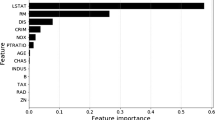Abstract
A family of multivariate representations is introduced to capture the input–output relationships of high‐dimensional physical systems with many input variables. A systematic mapping procedure between the inputs and outputs is prescribed to reveal the hierarchy of correlations amongst the input variables. It is argued that for most well‐defined physical systems, only relatively low‐order correlations of the input variables are expected to have an impact upon the output. The high‐dimensional model representations (HDMR) utilize this property to present an exact hierarchical representation of the physical system. At each new level of HDMR, higher‐order correlated effects of the input variables are introduced. Tests on several systems indicate that the few lowest‐order terms are often sufficient to represent the model in equivalent form to good accuracy. The input variables may be either finite‐dimensional (i.e., a vector of parameters chosen from the Euclidean space \(\mathcal{R}^n\)) or may be infinite‐dimensional as in the function space \({\text{C}}^n \left[ {0,1} \right]\). Each hierarchical level of HDMR is obtained by applying a suitable projection operator to the output function and each of these levels are orthogonal to each other with respect to an appropriately defined inner product. A family of HDMRs may be generated with each having distinct character by the use of different choices of projection operators. Two types of HDMRs are illustrated in the paper: ANOVA‐HDMR is the same as the analysis of variance (ANOVA) decomposition used in statistics. Another cut‐HDMR will be shown to be computationally more efficient than the ANOVA decomposition. Application of the HDMR tools can dramatically reduce the computational effort needed in representing the input–output relationships of a physical system. In addition, the hierarchy of identified correlation functions can provide valuable insight into the model structure. The notion of a model in the paper also encompasses input–output relationships developed with laboratory experiments, and the HDMR concepts are equally applicable in this domain. HDMRs can be classified as non‐regressive, non‐parametric learning networks. Selected applications of the HDMR concept are presented along with a discussion of its general utility.
Similar content being viewed by others
References
L. Chen, H. Rabitz, D. Considine, C. Jackman and J. Shorter, J. Geophys. Res. (1997), in press.
S. Cho, J. Carmichel and H. Rabitz, Atm. City Environ. 21 (1987) 2589.
P. Diaconis and M. Shahshahani, SIAM J. Sci. Statist. Comput. 5(1) (1984) 175–191.
A. Douglass and R. Stolarski, Geophys. Res. Lett. 16(2) (1989) 131–134.
B. Efron and C. Stein, Ann. Statist. 9(3) (1981) 586–596.
A.D. Egorov, P.I. Sobolevsky and L.A. Yanovich, Functional Integrals: Approximate Evaluation and Applications (Kluwer, Dordrecht, 1993).
J. Friedman and W. Stuetzle, J. Amer. Statist. Assoc. 76 (1981) 817–823.
F. Girosi and T. Poggio, Neural Comput. 1 (1989) 465–469.
W.J. Gordon, Distributive lattices and the approximation of multivariate functions, in: Proc.Symp. Approximation with Special Emphasis on Spline Functions, Madison, WI, 1969, ed. I.J. Schoenberg (Academic Press, New York, 1969) pp. 223–277.
T.L. Hill, Statistical Mechanics: Principles and Selected Applications (Dover, New York, 1987).
T. Ho and H. Rabitz, J. Phys. Chem. 97(51) (1993) 13447–13456.
T. Homma and A. Saltelli, Reliabil. Eng. Syst. Safety 52 (1996) 1–17.
P. Huber, Ann. Statist. 13(2) (1981) 435–525.
C. Jackman, A.R. Douglass, D. Considine and E. Fleming, NASA/GFSC model (1993).
G.G. Lorentz, M.V. Golitschek and Y. Makovoz, Constructive Approximation (Springer, New York, 1996).
B. Øksendal, Stochastic Differential Equations (Springer, Berlin, 1995).
D. Parker, Learning logic, Working Paper No. 47, Center for Computational Research in Economics and Management Science, Massachusetts Institute of Technology (1985).
T. Poggio and F. Girosi, Proc. IEEE 78 (1990) 1481–1497.
H. Rabitz, Science 246 (1989) 221–226.
H. Rabitz, M. Kramer and D. Dacol, Ann. Rev. Phys. Chem. 34 (1983) 419–461.
H. Rabitz and K. Shim, Multicomponent semiconductor material discovery using a generalized correlated function expansion, J. Chem. Phys. (1999), submitted.
A. Saltelli and I. Sobol, Reliabil. Eng. Syst. Safety 50 (1995) 225–239.
G. Schatz, Rev. Modern Phys. 61 (1989) 669–688.
H. Scheffe, The Analysis of Variance (Wiley, New York, 1959).
K. Shim and H. Rabitz, Phys. Rev. B 58 (1998) 1940–1946.
J. Shorter, P.C. Ip and H. Rabitz, An ultra-fast chemistry solver using high dimensional model representations, J. Phys. Chem. (1999), in press.
J. Shorter and H. Rabitz (1999), in preparation.
Y. Shreider, The Monte Carlo Method (Pergamon Press, Oxford, 1967).
B. Simon, Functional Integration and Quantum Physics (Academic Press, New York, 1979).
I. Sobol, Math. Modeling Comput. Exp. 1 (1993) 407–414.
T. Stoker, Econometrica 54 (1986) 1461–1481.
C.J. Stone, Ann. Statist. 10 (1982) 1040–1053.
C.J. Stone, Ann. Statist. 13 (1985) 689–705.
A. Tikhonov and V. Arsenin, The Solution of Ill-Posed Problems (Wiley, Washington, DC, 1977).
H. White, Artificial Neural Networks: Approximation and Learning Theory (Blackwell, Cambridge, MA, 1992).
Author information
Authors and Affiliations
Rights and permissions
About this article
Cite this article
Rabitz, H., Aliş, Ö.F. General foundations of high‐dimensional model representations. Journal of Mathematical Chemistry 25, 197–233 (1999). https://doi.org/10.1023/A:1019188517934
Issue Date:
DOI: https://doi.org/10.1023/A:1019188517934




